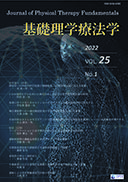Volume 25, Issue 1
Displaying 1-11 of 11 articles from this issue
- |<
- <
- 1
- >
- >|
-
2022Volume 25Issue 1 Pages 1-9
Published: 2022
Released on J-STAGE: October 17, 2022
Advance online publication: February 04, 2022Download PDF (2407K) -
2022Volume 25Issue 1 Pages 10-17
Published: 2022
Released on J-STAGE: October 17, 2022
Advance online publication: February 05, 2022Download PDF (5823K) -
2022Volume 25Issue 1 Pages 18-26
Published: 2022
Released on J-STAGE: October 17, 2022
Advance online publication: February 06, 2022Download PDF (5115K) -
2022Volume 25Issue 1 Pages 27-34
Published: 2022
Released on J-STAGE: October 17, 2022
Advance online publication: June 21, 2022Download PDF (2391K) -
2022Volume 25Issue 1 Pages 35-42
Published: 2022
Released on J-STAGE: October 17, 2022
Advance online publication: June 27, 2022Download PDF (2228K)
-
2022Volume 25Issue 1 Pages 43-49
Published: 2022
Released on J-STAGE: October 17, 2022
Advance online publication: August 26, 2022Download PDF (1933K) -
2022Volume 25Issue 1 Pages 50-55
Published: 2022
Released on J-STAGE: October 17, 2022
Advance online publication: August 27, 2022Download PDF (883K) -
2022Volume 25Issue 1 Pages 56-60
Published: 2022
Released on J-STAGE: October 17, 2022
Advance online publication: August 29, 2022Download PDF (985K) -
2022Volume 25Issue 1 Pages 61-68
Published: 2022
Released on J-STAGE: October 17, 2022
Advance online publication: August 30, 2022Download PDF (5039K) -
2022Volume 25Issue 1 Pages 69-79
Published: 2022
Released on J-STAGE: October 17, 2022
Advance online publication: September 28, 2022Download PDF (2049K) -
2022Volume 25Issue 1 Pages 80-85
Published: 2022
Released on J-STAGE: October 17, 2022
Advance online publication: September 29, 2022Download PDF (2911K)
- |<
- <
- 1
- >
- >|
